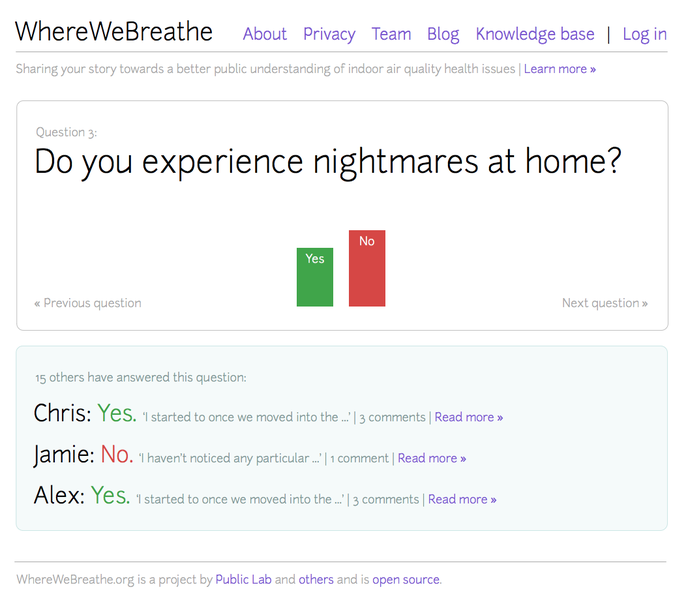
WhereWeBreathe
Here, we're collecting draft text for the WhereWeBreathe.org website (being planned on Github: https://github.com/publiclab/wherewebreathe/issues/)
Privacy dashboard:
Stay anonymous
There's no reason to share your real name, address, or contact information. Share your data under a false name and be careful of the potentially identifying information you decide to share.
We work hard to keep your data secure, and don't need to know who you are…
Know who's reading
You can decide to share privately with our team of epidemiologists and social scientists, and the information you supply will only be used for scholarly purposes and in a non-identifying manner.
If you choose to make your data public, anyone will be able to read your story to learn about indoor air contamination in mobile homes.
Am I looking for a VIN or a HUD number?
VIN
If you are residing in a home that could be classified as a "recreation vehicle," "commercial coach," "camping vehicle," "travel trailer," "park trailer," or "tip-out,"it is regulated as a vehicle by the Department of Transportation and will have a Vehicle Identification Number or VIN. A VIN number is engraved into the tow bar of travel trailers and campers and also printed on their title. A VIN number are 17-charecters long.
Image of A VIN number (sometimes they are embossed straight into the tow hitch and can be a bit more difficult to locate)
HUD
If you are residing in a "mobile home" or "manufactured home" that is built for permanent occupancy by a single family, it is regulated by the Department of Housing and Urban Development (HUD) and will have a serial number or HUD number.
The HUD certification number or the serial number can be found on mobile or modular homes on the tow bar, on the data plate on the exterior, on the bill of sale, on the home’s title or, sometimes, behind a bedroom closet door, electrical panel box door, or kitchen cabinet door, each section of a double or triple-wide will have its own serial number. They are typically composed of three letters followed by six or seven numbers.
_Image of a HUD number on the exterior of a mobile home. _
For more help in understanding or locating you HUD number see this helpful blog post.
Knowledge Base
((((((Developer note, could you please download pdfs and host them on our site to future proof the site as links to pdfs are likely to change))))) General information on Domestic Indoor Air Quality The average formaldehyde level in manufactured homes ranges from 15.5 ppb (CDC, PDF) to 36.3 ppb (California’s Office of Environmental Health and Hazard Assessment, PDF)—about four times higher than those of conventional homes.
Lawrence Berkeley National Laboratory has an indoor air quality scientific findings resource bank that is extensive (Link). The EPA's website on the indoor air quality of homes (Link). The EPA's Toxicological Review on Formaldehyde Inhalation (Link). For more information call the EPA Toxic Substance Control Act (TSCA) Assistance Line (202) 554-1404. Mitigation Very early NASA study on using plant to clean indoor air, also known as phytoremediation (PDF). More recent study on phytoremediation(Link). Study on the factors of chronic residential formaldehyde exposure. Over time ventilation lost its efficacy in mitigating formaldehyde levels and source removal was the most effective mitigation technique. (Link). Some formaldehyde in your home could be coming from permanent press fabrics which are treated with DMDHEU (1,3-dimethylol-4,5-dihydroxyethylene urea), which is formaldehyde based, to keep them free of wrinkles. One study found that washing these cloths in slightly acidic deionized water reduced the amount of formaldehyde coming out of them. Yet, washing them slightly-to-moderately alkaline water, like the tap water in New Orleans, increased the formaldehyde off-gassing (Link). Unless you have a lot of these kinds of shirts, this will likely be a minor contributor to decreased indoor air quality.
Studies on the Air Quality of FEMA Trailers Centers for Disease Control and Prevention's Studied on FEMA trailers (Link). The Agency for Toxic Substances and Disease Registry tests from 2007 (Link). A pilot study on the health effects of FEMA trailers on children was completed in the Fall of 2013 (Link).
FEMA Trailer Sales Certificates The conditions of sale and liabilities of the various models of FEMA trailer can be viewed in the following document acquired by way of the Freedom of Information Act (PDF). this document isn't online but I (Nick) can email it to the developer
Advocates Safer Chemicals Healthier Families (Link). Blog by the Director of the Sierra Club Formaldehyde Campaign (Link).

